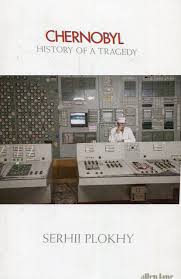Serhii Plokhy (2019) Chernobyl: History of a Tragedy.
Posted by celticman on Sat, 17 Aug 2019

Serhii Plokhy’s history of Chernobyl won the Baillie Gifford Prize for Non-Fiction 2018. He tells us what happened when reactor No 4 in the Chernobyl Nuclear Power plant, named after Vladimir Lenin, exploded after what should have been a routine maintenance test on 26th April 1986. First to arrive where firemen, who hooked up their hoses and treated it as a routine fire, no immediate threat to the around 5000 workers and their families living in Prypiat. Some of the firemen picked up or kicked graphite, which had been inserted into the reactor in an attempt to slow down the nuclear reaction taking place. Later helicopter pilots dropped thousands of tonnes of sand and lead into the space left open after the roof had blown off and flipped over. Miners were brought in to dig tunnels and freeze the earth beneath No.4 reactor. The main objective was to prevent the building from sinking and contaminated water flowing into the ground water and into the Prypiat River, the Dneiper River, the Black Sea, the Mediterranean, the Atlantic. It sounds a bit like one of those games you had when you were young and wrote your name and the street you lived in, the town and city and ended up saying – at the end -- and the universe.
Soviet scientists were able to explain the technical reasons, how the reactor had failed, but they weren’t able to explain what measures, if any, stopped the nuclear explosion from continuing and wiping out complex life on Earth. The China syndrome, nuclear meltdown, was theoretical, but became a practical problem and not just for armchair physicists. Radiation affected everyone and everything, far and wide, but the closer to the epicentre of the reaction the possibility of tissue damage was higher.
Plokhii puts it into perspective in the Preface:
Altogether 50 million curies of radiation were released by the Chernobyl explosion, the equivalent of 500 Hiroshima bombs. All that was required for such catastrophic fallout was the escape of less than 5 percent of the reactor’s nuclear fuel. Originally it had contained more than 250 pounds of enriched uranium – enough to pollute and devastate most of Europe. And if the other three reactors of the Chernobyl power plant had been damaged by the explosion of the first, then hardly any living and breathing organisms would have remained on the planet.
Over 500 000 workers and soldiers were brought in to deal with the aftermath. I didn’t give it much thought at the time. Like most others I thought Chernobyl was a place spot in history, a no-go zone for humanity. Reactor No.4, where the explosion took place, was covered in concrete and a special roof constructed to keep levels of radiation minimised and localised, but the other reactors continued to produce power and electricity for the Ukrainian economy for the next twenty years.
This astounded me more than Stalinesque cover-up and KGB clamp down on dissidents that refused to toe the party line that it was business as usual. Weddings and parties still took place in the city of Pyripiat in the immediate aftermath of the explosion. A 1st May Day Parade in Kyiv, the capital, less than 100 km away took place, while radiation levels were increasing and threatened the life of adults, but children were particularly susceptible to the invisible poisoning as was typically shown by thyroid damage.
Plokhy shows how the fallout spread to other countries. Belarus was affected proportionately worse than the Ukraine in terms of land mass and was first to declare independence from the Soviet Union. Dissidents in the Ukraine were able to use Gorbachev’s perestroika to galvanise support for power sharing and transparency around the cover up of what happened at the Chernobyl plant. They were able to argue they should no longer be a satellite state used as a testing ground for the new technology of nuclear fuel and combine the tragedy of what happened for a call to arms. Full independence and control of the Ukraine, the breadbasket of Russia and second largest of its satellite states.
With Russia becoming bankrupt and Boris Yeltsin becoming President, Ukraine became an independent nation. Chernobyl the focal point of dissent was now an economic albatross, yet the reactors around it were still needed to produce energy for a shrinking economy. Plokhy shows how the intellectuals and dissidents and high-faulting words began to sound very like Bill Clinton’s ‘it’s the economy, stupid!’
Chernobyl asks a very simple question of us, could it happen again? The History of a Tragedy suggests that as the poorer nations out with the Western world adapt nuclear technology as a cheap fix it is more rather than less likely to happen.
We’ve been here before. We are there now. Global warming and denial by the moron’s moron in the White House has the same sense of cover-ups and lies, but it is to American interests and fossil fuels, not nuclear, that is far more likely to lead to Armageddon. It would be a mistake, however, to believe that you cannot have one without the other. Both are possible when sectional interests, as shown here, take precedence over common humanity. I just hope there’s some historian around like Serhii Plokhy to write it up.
- celticman's blog
- Log in to post comments
- 906 reads


